Whale Sanctuary of El Vizcaino
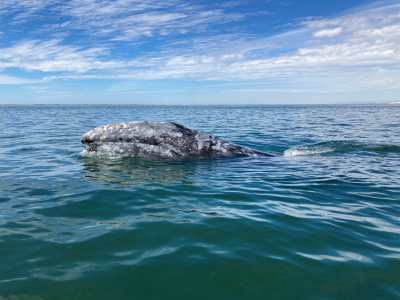
The Whale Sanctuary of El Vizcaino comprises the breeding grounds for the North Pacific Grey Whale and also protects other important species.
The Grey Whale yearly travels in small groups between feeding and breeding grounds over a distance of 16,000-22,000 km. They use the shallow, well-protected lagoons of Ojo de Liebre and San Ignacio to mate, breed and calve. The area also is productive for fish and sees an abundance of wintering bird species.
Community Perspective: The season lasts from January to mid-March. You can choose between Guerrero Negro (for Ojo de Liebre) or San Ignacio (for San Ignacio Lagoon) to use as a base: from there, trips on small boats will be on offer to view the whales.

Map of Whale Sanctuary of El Vizcaino
Community Reviews
ZCTLife
Every winter, gray whales enter the bays on the Pacific side of the Baja peninsula to breed and rear young. The warm water is high saline and shallow enough that an adult whale can often touch bottom with their tails with their heads above the surface. Like giant hot tubs, these blue lagoons are perfect for adult whales to meet up and mate. Like a kiddie pool, these nurseries are perfect for babies to practice holding their breath, to open their eyes underwater and to learn to swim. And like top rated world heritage sites, these bays—named after a Spanish explorer—are perfect for tourists to experience the best whale watching in the world, with a sizable concentration of gray whales including babies, accessible from nearby beaches in small boats, with up close encounters, even touching.
The northeast Pacific population of gray whales has been decreasing in recent years, but there are still hundreds counted here every winter. I visited in February, choosing the Ojo de Liebre (hare’s eye) lagoon. I drove from California and booked my own hotel for 2 nights, but most whale watchers book package tours including hotel accommodation in Guerrero Negro. Some stay in seasonal camps on the beach for days and go out on the water multiple times. I went out once and fortunately it was a good day with the whales.
Within 30 minutes, we boarded our small boat, motored out into the lagoon found some friendly whales and let them come up to see us. Almost immediately, one female came up and touched my hand. In a couple hours, we saw dozens of whales, including at least half a dozen right next to our little boat, and observed all the classic whale behaviors like the spy hop, pectoral fin wave, rolling over and breaching.
Before some self-proclaimed marine wildlife expert criticizes me for touching a whale, I repeat that the whale came up and touched my hand slowly, gently and on purpose, and she came back with a friend who swung her nose along everyone else’s hand a few minutes later. Watch the video on my website. The lagoons are restricted, tours are licensed and time on the water is limited. The guides and captains are experienced, dedicated to the whales and have spent much more time with them than you have. Gray whales are sometimes curious about humans, especially when people are squealing and laughing with joy to see them. And when the whales weren’t interested in interacting, we left them alone.
Some of the lagoons also have nesting sea turtles and there are plenty of other sights to see in the large Vizcaíno biosphere. The only way to see the whales (other than from the beach) is to book a tour. There aren’t enough stars to recommend highly enough. What are you waiting for?
Read more from ZCTLife here.
Clyde

I visited this WHS in 2024. Due to its location, it is much easier to visit from the United States and/or Canada (especially overland but also by flight) than it is from Mexico City.
There are flights to Loreto (still a good 3.5-4 hours drive to the San Ignacio base) from the United States (San Francisco, Los Angeles, Dallas and Phoenix), from Canada (Calgary) and from Tijuana (Mexico) but NOT from Mexico City. Wanting to avoid 2 internal flights CDMX-Tijuana-Loreto and back, and since the rental car rates with unlimited mileage as well as domestic flight prices were significantly cheaper on my planned dates, I opted to travel to Mexico City-La Paz (a much longer 8hr drive; a very boring extra 4 hours when compared to starting from Loreto). Still, when adding up the travel time to Tijuana plus the extra costs involved, the time difference, and keeping in mind the added bonus of being able to visit the newly added Gulf of California WHS component of Balandra, I used La Paz as my southern base and San Ignacio as my northern base.
San Ignacio is still a good 1.5 hour drive away (with around 25 kilometres of dirt road driving on compacted sand and gravel; doable slowly with a standard non-4WD vehicle on a sunny day) from the San Ignacio Lagoon area where the boat tours depart from. The Ojo de Liebre Lagoon is also reachable with a further drive to Guerrero Negro and then a much more bumpy dirt road to the boat tour departure point. The plus point when choosing the latter is the better chance of spotting the endangered Baja California Pronghorn, the second fastest animal on the planet after the cheetah, thanks to the excellent work of a breeding center nearby. After all, the El Vizcaino Biosphere Reserve is the largest wildlife refuge in Mexico, so large that it encompasses 2 WHS: the El Vizcaino North Pacific lagoons and whale sanctuaries, and the El Vizcaino marine and coastal belt in the Gulf of California. The site is also a Ramsar site, so expect to see lots of birds of prey, especially ospreys, kites and caracaras.
Make sure to book ahead (by email and/or by phone/whatsapp) as the few accommodation options at San Ignacio fill up very quickly. We stayed at the reasonably priced La Muralla Motel just opposite the expensive Ignacio Springs B&B and were able to use all the latter's facilities and help to book a driver and arrange a guide for the Rock Paintings of the Sierra San Francisco. The driver service is the most expensive part as they charge a flat rate of 3500 pesos/210 USD for a maximum of 12 people but you're very likely to be the only one going for the rock paintings tour and/or the whale watching trip. While a 4WD high clearance vehicle is surely needed for the Sierra San Francisco WHS, it isn't to get to the San Ignacio Lagoon. It is advisable to let the hotel and boat tour company know that you'll be driving there on your own and make sure to have plenty of time/water to spare in case you have any mechanical problems with the car as there is no mobile phone reception for most of the dirt road near the salt plains.
Due to time constraints, and since I wanted to visit the Sierra San Francisco on the following day, I joined Antonio's Eco Tours on a 2 hour whale watching trip. For those who want to spend more time in the area and do more than one whale watching trip, they also have eco cabins but again book in advance. A boat trip now costs 70 USD and includes the conservation bracelet entrance fee (lunch is also available for an extra 12 USD). The whale watching boat trip lasts for 2 hours. Boats are allowed 90 minutes inside the whale watching area, plus 15 minutes to go in and another 15 minutes to go back to the departure point. The shallower areas deeper in the lagoon are out of bounds so as to not disturb the whales during mating season (especially since the male whales breach quite often to impress female whales). However, if you look closely over the horizon between the small islets with huge sand dunes and the rest of the rocky landscape, you'll surely spot more than one whale breaching.
The whale watching area is much deeper and is also the point from where the grey whales enter/exit the lagoon to mate, breed and calve. It is the perfect spot to see scores and scores of whales with their young at very close distance. There were so many whales around the small boat that everyone had more than enough opportunities to see the whales up close and snap some photos. The mother whales with their young seemed to be the most curious and kept bobbing out of the water to get a good look at us and some wouldn't leave the boat's trail unless that got a fair amount of pats from the passengers onboard. I wasn't too eager to touch the whales, out of fear and respect, but two whales in particular kept bobbing just next to my side (and also hitting the bottom of the boat a couple of times!), sort of expecting a friendly pat, and in the end I went for it and I must confess that it was truly a magical and humbling moment to be able to "interact" with such gentle giants.
If you visit in the right season, you're guaranteed to at least see scores of grey whales and bottlenose dolphins. If you're lucky, you'll be able to pat them, and also perhaps get a chance of spotting some orcas or other harder-to-see whales. Do bring a cap and sunscreen as there will be no shade, and take sea-sickness pills if you usually need them and go to the restroom before departure time. At the different departure points, and at the beginning of each dirt road providing access to them, I spotted different UNESCO WHS inscription and information boards: one next to our departure point, and another two several kilometres away at points locally known as San Zacarias and San Juan de las Pilas.
It was also shocking to see how many of the grey whales died and washed up to the shores between 2018 and 2023. Almost every boat trip company has tens of whale skeletons on the shores just next to a few rusty remains from the whaling industry. The whale die-off was significant with around 690 gray whales washing ashore in the US, Mexico and Canada, most probably because of too little food available along its epic migratory route possibly linked to climate change. Luckily scientists now believe that the die-off is over. The grey whale population is believed to have plummeted to 14,526 in 2023 from 20,500 in 2019, while calf production was estimated at 217 in 2022, down from about 950 in 2018. The good news is that in 2023 and 2024, there was a sort of rebound effect with good signs of repopulation, and now the total population is estimated to be around 21,300 grey whales. Overall really a great WHS thanks to the whale migration!
Els Slots

I visited the Grey whales at San Ignacio Lagoon, one of the two locations that make up the Whale Sanctuary of El Vizcaino. The B&B where I was staying (Ignacio Springs) booked the whale tour for me – beforehand I thought that you had to book as early as possible, but the lady just phoned in the night before. As always with sea-based tours: the weather & wind can cause cancellations, so it’s best to allow for a couple of days in the area (also to tick off the nearby Rock Paintings of the Sierra de San Francisco WHS, with which it even shared the initial nomination until they were wisely split up by World Heritage Bureau).
From the town of San Ignacio, which lies on Highway 1, it’s another 1-1.5 hour drive to get to the actual lagoon. The first 45km is on an easy, paved road, the last 15 on a relatively bumpy unpaved one. There’s nothing here but a few basic camps and some mudflats. The operator I used was Antonio’s Ecotours, which asks 60 USD per person for the tour. The boats can hold up to 12 people, but on mine were only 5. I was welcomed at Antonio’s, got a safety jacket fitted on and on we went in the small motorboat. The boats are only allowed to go whale watching at the mouth of the lagoon, not inside the lagoon itself as that is too shallow and would endanger the whales.
The tour lasted 2 hours, of which only 10 minutes each were spent getting to and from the main viewing area. We basically just entered “the zone” and waited. It did not take long to see whale activity left and right. It was estimated that at the time of my visit (February 1), 100 Grey whales were present at the lagoon. This number will continue to rise till the end of February when there could be as many as 200. Sometimes other species come as well, such as Orcas (who hunt the Grey whale babies). We also saw Bottlenose dolphins and turtles.
With so many whales around us, we could enjoy their behaviour. We observed a few in the distance jumping out of the water with almost their whole body. We spent quite some time with a mother and calf, the little one keeping mum’s side all the time and producing little puffs of water. Also, we found one sleeping – just a big thing floating on the water, until it got annoyed by our presence, lifted its head, and moved on.
There is a number of reasons that make this such a unique site:
- the sheer amount of whales you see, often you are surrounded by several of them at the same time,
- the chance to see mothers and calves together,
- the fact that the whales aren’t just passing by but actually are living (mating, breeding) in the area,
- how close you get to them, sometimes they even can be petted,
- the low-key approach of the whale watching tourism (small boats, and they leave each other alone and do not crowd around sightings as is often done at jeep safaris).
So far we have gathered 29 WHS in our “Whales” connection. However, this is the only site dedicated primarily to whales, and together with Peninsula Valdes only one of two that derive their OUV from whales. I’ve done 3 other whale watching tours over the years (Iceland, Azores, Peninsula Valdes), but this one was by far the most productive ánd the most pleasant experience.
Read more from Els Slots here.
Traveling Girl

This is a site that I have visited 3 times, and, for animal lovers, it does not disappoint. I'm based in Southern California, so it's a long but do-able drive down the west side of Baja. In 2017, we drove and enjoyed the incredible "super bloom" in the desert. In March 2020, we flew from Los Angeles to Loreto, and were in the area precisely as the Covid Lockdown was occurring. The lockdown altered the last few days of our trip only.
Unfortunately, the Baja area can be challenging to find accommodations. There are no chain hotels in the central area, such as San Ignacio, which is the most centrally located for whale watching. There are some bigger places in Guerrero Negro that might be perfect for people driving down. We booked a small house through hotels.com in San Ignacio. Internet was very sketchy there and the accommodations are very basic. Also it can be difficult to plan the boating trips in advance. This can limit the pre-trip enthusiasm, because it's a long drive in from either the West or East Baja coast, and people prefer to know with certainty that they'll be getting on a boat once they get there. Somehow, it's always worked out for us.
It's a fairly long (30-45 minutes) drive to the dock from San Igancio, and about the same if you're going to the Guerrero Negro sites. The roads are dirt. There's little or no traffic. It's marked but not often.
The boats, small "panga" fishing boats, hold about 8-12 passengers. The boats leave from the dock twice a day. Mornings are usually calmer. Your captain may or may not speak English. Many are Spanish speaking only. There is no educational narrative. You'll take the boat out of the docking area and into the deeper part of the bay. If you go in the heart of calving season, and before they head north, there will be whales everywhere. A fin here, tails there, spouts or breeching there. Some will be very near the boat, some (most) off in the distance. Your captain will try to get you close to as many whales as he can. Ideally, you'll find some whales that are curious about the boat, and hang around or swim slowly nearby. The very curious ones might come up and hang around the boat for a while... a few minutes to half an hour or more... and come up to have a close look at you. It's incredible to look eye to eye with a whale that's come up to your boat to have a peek at you. People will reach out and touch them if they get that close.
For anyone interested in whales, it's a trip worth doing.
Michael Novins

In February 2011, I took the bus from Loreto to San Ignacio, where I spent two nights at Ignacio Springs (www.ignaciosprings.com) and visited the two nearby UNESCO World Heritage Sites. On my first full day, I traveled to San Ignacio Lagoon, the only undeveloped nursery and breeding ground of the Pacific gray whale and part of the Whale Sanctuary of El Vizcaino UNESCO World Heritage Site (http://www.kuyima.com). We spent nearly two hours on the lagoon, and saw dozens of gray whales, often several at one time, some within a few feet of the panga (boat). On my second day, I visited the El Palmarito Caves, part of the Rock Paintings of Sierra de San Francisco UNESCO World Heritage Site. The trip started with a two-hour drive, mostly through an unimproved wash bed, to Rancho Santa Marta, followed by a one-hour hike and 30-minute climb up a rocky incline to the stunning cave -- due to its remoteness and difficult access the cave is not as frequently visited as some of the more accessible caves in the region, and I was the only visitor at the cave. I ended my trip in Loreto, where I stayed at La Damiana Inn, built in the 1930s (www.ladamianainn.com).
Kelly Henry
This place is truly an off the beaten path treat! Although it is a bit difficult to reach, it can be easily seen along with The Rock art of San Francisco. This reserve is the winter home of more than 12,000 grey whales. They migrate here from the arctic ocean to give birth and enjoy the winter weather.
Vizcaino biosphere is best visited from Guerrero Negro, a small town about 450 miles south of San Diego in California. You can drive the entire distance on a good 2-lane highway.
The whales enter the salt lagoons in January and remain until Mid-March. The lagoons have a very high salt content (in fact, parts are a Japanese owned salt works that UNESCO worked hard to prevent expansion.) Females have their babies here because of a boost in floatation due to the saltiness. Entrance to the lagoons is strictly controlled but you can take a boat out into the lagoons for about 49 US dollars per person for 3 hours. Lots or tours are offered but you can just show up and join a small boat trip.
The boats quickly find the whales who are seemingly everywhere you look. They come right up to the boats and sometimes nudge them. The moms and babies swim together and you will assuredly see them jumping (breeching), diving, and generally playing.
There are about 7 or 8 modest hotels (don't expect much) and some great Mexican seafood restaurants in Guerrero Negro.
Site Info
- Full Name
- Whale Sanctuary of El Vizcaino
- Unesco ID
- 554
- Country
- Mexico
- Inscribed
- 1993
- Type
- Natural
- Criteria
-
10
- Categories
- Natural landscape - Marine and Coastal
- Link
- By ID
Site History
1993 Inscribed
1990 Deferred
Only a part might be of Universal Value -rest should be Biosphere reserve. Possible adding a cultural dimension to criteria??
Site Links
Unesco Website
Official Website
Related
In the News
Connections
The site has 25 connections
Ecology
Geography
Human Activity
Timeline
Trivia
Visiting conditions
WHS Names
WHS on Other Lists
World Heritage Process
Visitors
41 Community Members have visited.
The Plaque
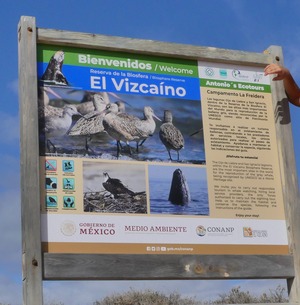 (photo by Clyde)
(photo by Clyde)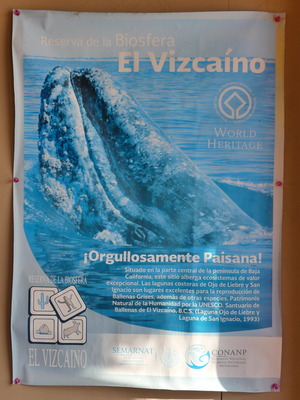 (photo by Clyde)
(photo by Clyde)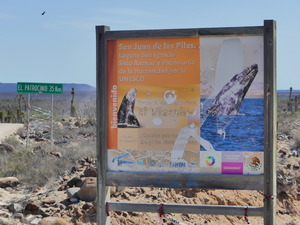 (photo by Clyde)
(photo by Clyde)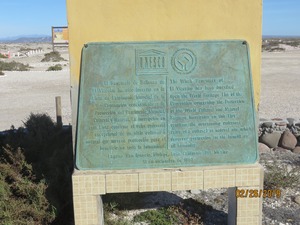 (photo by Anthony Sun)
(photo by Anthony Sun)